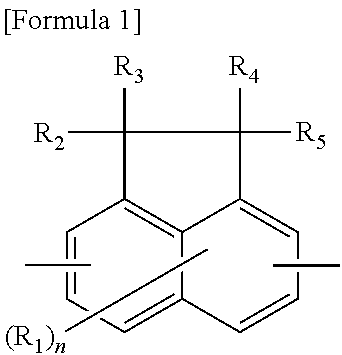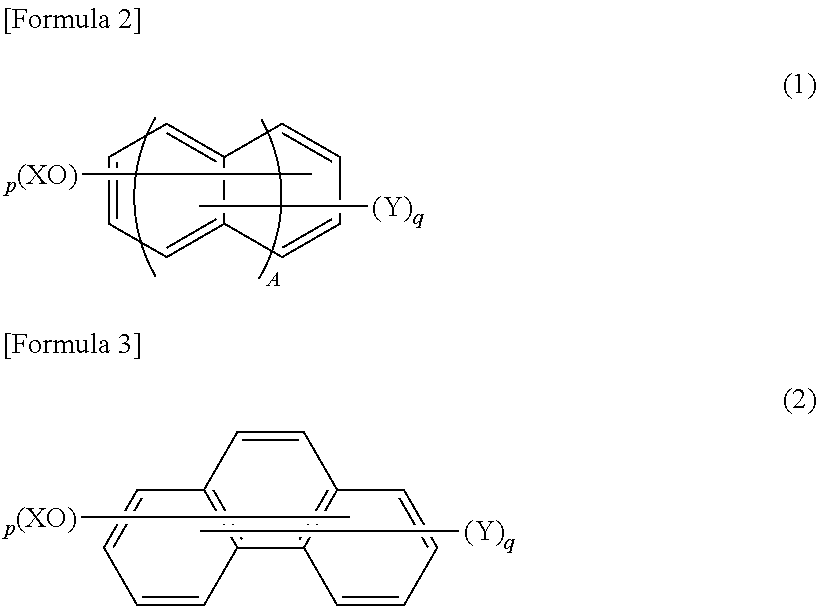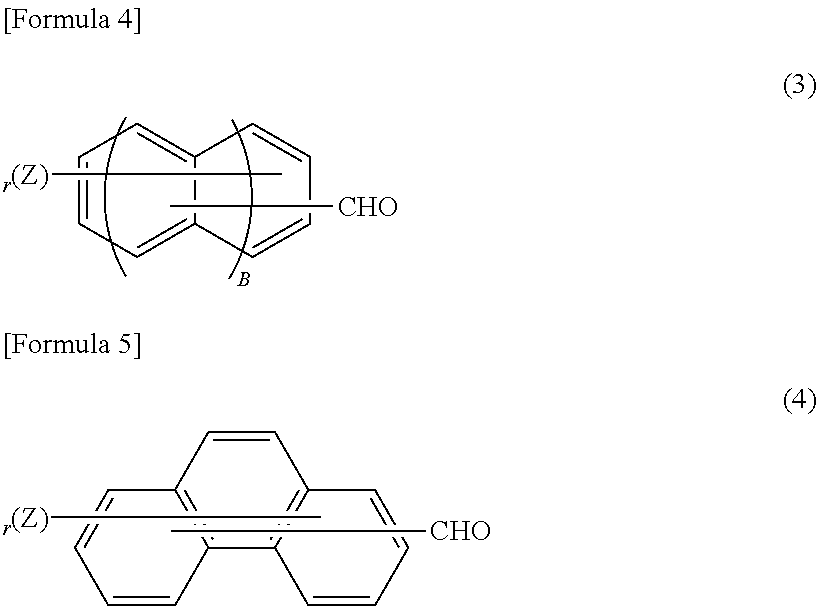Phenolic resin and material for forming underlayer film for lithography
a lithography and underlayer technology, applied in the field of phenolic resin, can solve the problems of complex reaction, high cost of materials, and the intrinsic limitation of the wavelength of light sources, and achieve the effects of low oxygen concentration, high heat resistance, and high carbon concentration
- Summary
- Abstract
- Description
- Claims
- Application Information
AI Technical Summary
Benefits of technology
Problems solved by technology
Method used
Image
Examples
synthesis example 1
[0159]To a four-neck flask having an inner volume of 1 L, equipped with a Dimroth condenser, a thermometer and a stirring blade, were charged 144 g (1.0 mol) of 1-naphthol (produced by Acros Organics) and 182 g (1.0 mol) of biphenylaldehyde (produced by Mitsubishi Gas Chemical Company, Inc.) under a nitrogen stream, and heated and melted at 120° C., thereafter, 0.5 ml of methanesulfonic acid (produced by Kanto Chemical Co., Inc.) was added thereto to start a reaction, and immediately thereafter, the temperature was raised to 220° C. to allow the reaction to run for 6 hours. At 2 hours and 4 hours after the start of the reaction, 0.5 ml of methanesulfonic acid was added thereto. The resultant was diluted with 400 g of methyl isobutyl ketone (produced by Kanto Chemical Co., Inc.) and 200 g of anisole (produced by Kanto Chemical Co., Inc.), and then neutralized and washed with water, and the solvent was removed under reduced pressure to thereby provide 255 g of a phenolic resin (NF-1) ...
synthesis example 2
[0163]To a four-neck flask having an inner volume of 1 L, equipped with a Dimroth condenser, a thermometer and a stirring blade, were charged 144 g (1.0 mol) of 1-naphthol (produced by Acros Organics) and 182 g (1.0 mol) of biphenylaldehyde (produced by Mitsubishi Gas Chemical Company, Inc.) under a nitrogen stream, and heated and melted at 120° C., thereafter, 3.0 g of oxalic acid (produced by Kanto Chemical Co., Inc.) was added thereto to start a reaction, and immediately thereafter, the temperature was raised to 220° C. to allow the reaction to run for 6 hours. At 2 hours and 4 hours after the start of the reaction, 3.0 g of oxalic acid was added thereto. The resultant was diluted with 400 g of methyl isobutyl ketone (produced by Kanto Chemical Co., Inc.) and 200 g of anisole (produced by Kanto Chemical Co., Inc.), and then neutralized and washed with water, and the solvent was removed under reduced pressure to thereby provide 190 g of a phenolic resin (NF-2) of Synthesis Example...
synthesis example 3
[0167]To a four-neck flask having an inner volume of 1 L, equipped with a Dimroth condenser, a thermometer and a stirring blade, were charged 144 g (1.0 mol) of 1-naphthol (produced by Acros Organics) and 156 g (1.0 mol) of 1-naphthaldehyde (produced by Kanto Chemical Co., Inc.) under a nitrogen stream, and heated and melted at 120° C., and thereafter, the temperature was raised to 220° C. (wherein the time of reaching 220° C. was defined as the start of the reaction) to allow the reaction to run for 6 hours. At 1 hour and 3 hours after the start of the reaction, 1.0 ml of methanesulfonic acid (produced by Kanto Chemical Co., Inc.) was added thereto. The resultant was diluted with 400 g of methyl isobutyl ketone (produced by Kanto Chemical Co., Inc.) and 200 g of anisole (produced by Kanto Chemical Co., Inc.), and then neutralized and washed with water, and the solvent and the unreacted raw materials were removed under reduced pressure to thereby provide 120 g of a phenolic resin (N...
PUM
| Property | Measurement | Unit |
|---|---|---|
| temperature | aaaaa | aaaaa |
| reaction time | aaaaa | aaaaa |
| reaction time | aaaaa | aaaaa |
Abstract
Description
Claims
Application Information
 Login to View More
Login to View More - R&D
- Intellectual Property
- Life Sciences
- Materials
- Tech Scout
- Unparalleled Data Quality
- Higher Quality Content
- 60% Fewer Hallucinations
Browse by: Latest US Patents, China's latest patents, Technical Efficacy Thesaurus, Application Domain, Technology Topic, Popular Technical Reports.
© 2025 PatSnap. All rights reserved.Legal|Privacy policy|Modern Slavery Act Transparency Statement|Sitemap|About US| Contact US: help@patsnap.com



